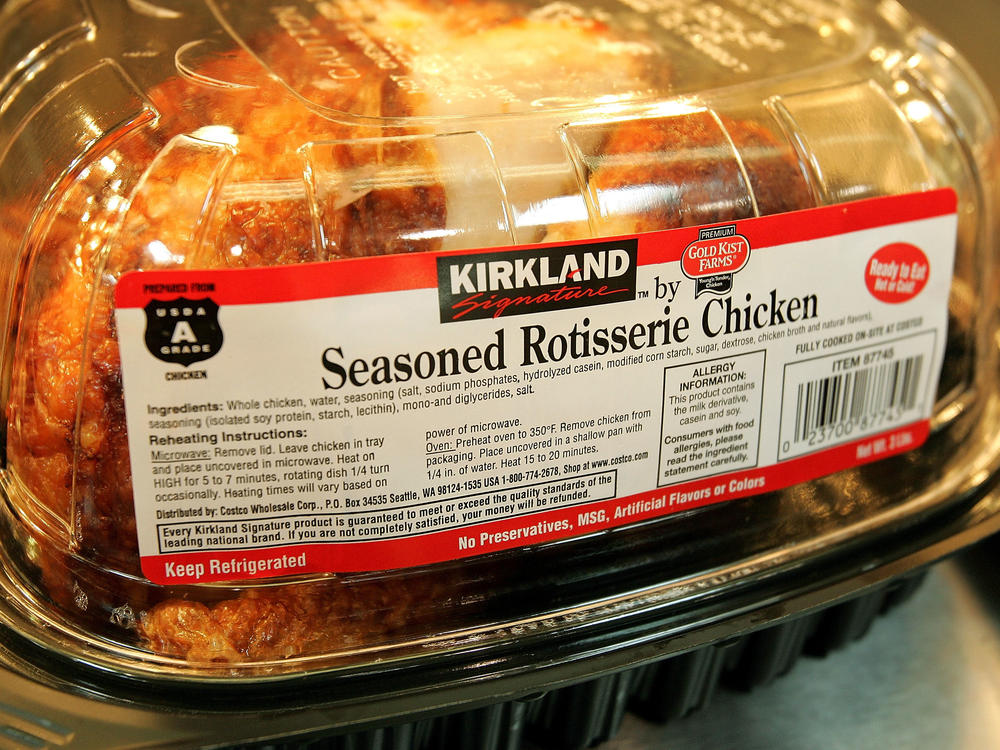Section Branding
Header Content
Inflation is raising prices on almost everything, except rotisserie chicken
Primary Content
Updated June 7, 2022 at 6:43 PM ET
Inflation is raising the price of all sorts of items in the grocery store, but one staple appears to be immune: rotisserie chicken.
That's not to say the poultry industry isn't suffering from soaring costs. Chicken prices nationwide have increased 16.4% in the year to April, according to the Consumer Price Index. And pointing to the ongoing bird flu outbreak, the U.S. Department of Agriculture predicts wholesale poultry prices will increase 15-18% this year.
But stores including Costco, BJ's and Sam's Club are keeping their rotisserie chicken prices low — $5 or less. Other chains, like Publix and Giant Eagle, remain in the $7 range.
Ernest Baskin, an associate professor of food marketing at Saint Joseph's University, tells Morning Edition that it's an example of loss leader pricing, a marketing strategy in which companies sell certain products below their market cost in order to get shoppers in the door — and, oftentimes, other higher-priced goods into their baskets.
Rotisserie chicken is a loss leader: visible and affordable
"It is a way of the store giving you a discount on a very highly prominent item and then making up the money on some of the other items in the store," he explains.
The prices of most goods are going up at every grocery store, Baskin adds, so retailers are trying to differentiate themselves by running discounts on items that are especially attractive to customers. In the case of stores such as BJ's and Costco, that's the beloved $4.99 rotisserie chicken.
During an earnings call last month, BJ's CEO Bob Eddy said the store has kept the low price "just because it's such a meaningful thing to our members." He said the chain makes similar investments in other "key member value items" like paper and water.
Rotisserie chickens in particular are a marketable combination of visible and affordable, Baskin notes.
"It's also in the store an aura of saying, 'Look, our prices are generally very low. We don't raise them unless we absolutely have to,' " he says. "They're giving a cheapness aura to the store, which is helpful for consumers when they're concerned about their spending power."
Even if shoppers are filling their carts with other goods that have gone up in price, he adds, they're likely feeling somewhat better because they've saved money on at least one highly visible item.
Grocery stores put the best-value stuff in the back for a reason
And once shoppers are inside, they'll typically have to traverse multiple aisles to get to the chicken — passing lots of other products along the way. That's no coincidence.
"The store really wants you to walk through the store, see what other items the store has, and ideally either consider putting them in your basket or actually take the step of putting them in your basket," Baskin says.
Costco sells rotisserie chickens at the back of its stores for this reason. Keeping rotisserie prices low is so crucial to the company that it even opened a poultry plant in 2019 in order to supply its own birds to its stores, as CNN Business reports. The Nebraska facility processes more than 100 million chickens a year.
And chicken isn't the only prepared food that Costco famously sells at a discount. Costco executive Bob Nelson took a moment during last month's earnings call to clear up a rumor that the chain was increasing the price of a food-court favorite.
"The price, when we introduced the hot dog-soda combo in the mid-'80s, was $1.50," he said. "The price today is $1.50, and we have no plans to increase the price at this time."
The audio for this story was produced by Ben Abrams and edited by Ally Schweitzer.
Copyright 2022 NPR. To see more, visit https://www.npr.org.

